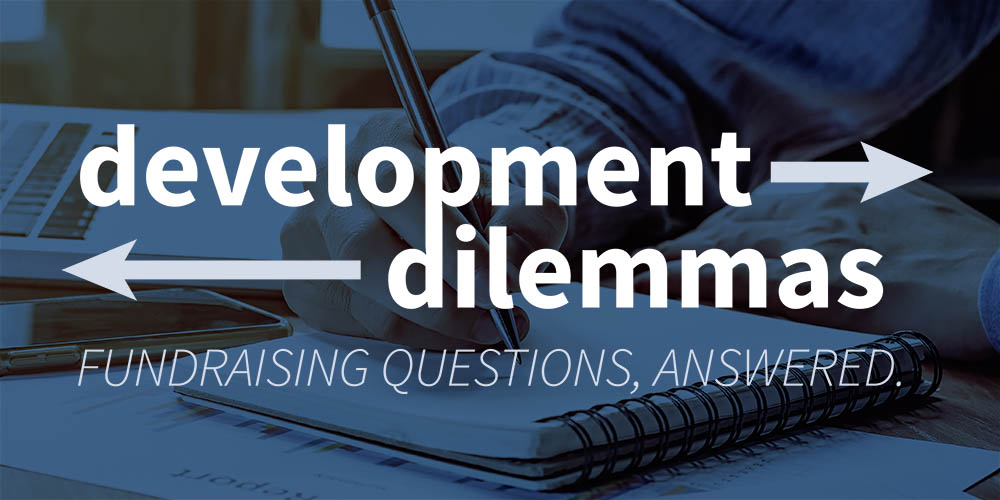In our weekly column, consultants with decades of nonprofit experience answer your questions about fundraising, boards, strategy and more. To ask a question and be featured (anonymously!) in the column, email your questions to info@twbfundraising.com.
This week’s question will be answered by Anne Smith.
The Dilemma
I just ended the fiscal year and I came in way under my goal I set for new donors. While we did well closing gifts from renewing donors, we didn’t receive as many new gifts as I expected.
I set my goal for new prospects using a 4:1 ratio, figuring that I would get 1 gift for every 4 new prospects. This looked like an industry benchmark. Is there a better way to arrive at a probability ratio to use for new donors?
Anne’s Response
This can be challenge if you’re not looking at your organization’s trends in detail. Once you do this work, it’s easier to maintain moving forward.
One simple probability ratio is often too simple to base your projections upon. Affinity, cultivation and capacity are important factors to consider when determining how many of that kind of prospect you will need per gift. It is helpful to segment your list of prospects into categories indicating the level of cultivation or interaction your organization has provided, any known capacity and degree of affinity to your organization’s mission or the board. Everyone on your revenue pipeline should go through this filter to help determine how “qualified” they are.
Your Organization's Trends
Look at the last 5 fiscal years of your organization’s pipeline performance: Total number of prospects and total revenue by category (foundations, events, direct mail, corporate, etc.), total number of prospects and resulting donors for each fiscal year, total number of new prospects and resulting new donors for each fiscal year and the total number of lapsed from each fiscal year.
Identify and explain any outliers like an unexpected big gift or something that isn’t repeatable. Perhaps pull them out to get a more honest picture of the trends for projection purposes.
Further Segmentation to Find Out Why and Determine the Probability
You may find that your organization has not measured some of these in previous years. In that case, apply them to the current year’s pipeline and continue tracking moving forward.
- Source of gift for each prospect that became a donor: specific online appeals, specific direct mail appeals, specific events, etc.
- Number of times asked: How many times did you ask your prospects? Did you ask your current donor for another gift? Remember that the most likely candidate to give is a current donor so asking more than once a year for very specific reasons with stewardship between the appeals can increase the revenue and average gift.
- Time of year: gift date may correspond with holidays, your own special event/campaign, or something that happened in the economy or political landscape
- Donor type: Foundation, Corporation, Individual, Event. These donor types behave differently and that behavior needs to be factored in when determining probability.
- Foundations will take 1 to 4 years to cultivate and often will renew for a couple of years before sun-setting.
- Corporations can result in giving within 1 -2 years but are more transactional and therefore giving is determined by the layers of benefits you can provide, your organization’s relationship with their key staff, and your mission’s fit with their company.
- Individuals may cultivate to a gift within a year but relationship and affinity play a significant role.
- Event donors are not fully converted donors. They are more transactional and therefore their giving is based more on benefits and social experiences. They need more personal cultivation to convert into donors.
- Affinity/Cultivation Categories will help you see your organizations history of performance to determine where you fall on the Prospect to Donor Ratio Range:
- Category 1: Prospect to Donor Ratio Range 2:1 – 5:1: current or recent donors/volunteers with continued communication and cultivation
- Category 2: Prospect to Donor Ratio Range 4:1 – 10:1: non-donor or lapsed with interaction and regular communication
- Category 3: Prospect to Donor Ratio Range 8:1 – 10:1: a second-degree friend like a board prospect who hasn’t been introduced to the staff and organization to cultivate
- Category 4: Prospect to Donor Ratio Range 10:1: a prospect who hasn’t met the organization but research shows they have some capacity and demonstrate a history of supporting similar causes (pay attention to their desire to support national vs. local and if those you serve are in a location they care about)
By looking at your pipeline performance through this lens, you will uncover strategies that trend in a positive direction. You will also see how affinity and cultivation effect your probability ratio and help you find a more accurate projection.
Once you put in the time to track and analyze this data, you will have a much stronger basis for projecting your success, with a clear path for continued measurement that will provide you, your executive director, and your board with more confidence in your pipeline and reports throughout the year. You’ve got this.



Comments
Questions or comments? Join the conversation!